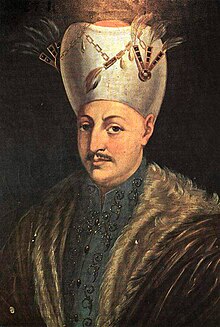| Ahmed I | |||||
|---|---|---|---|---|---|
| Ottoman Caliph Amir al-Mu'minin Kayser-i Rûm Custodian of the Two Holy Mosques | |||||
 Anonymous portrait of Ahmed I | |||||
| Sultan of the Ottoman Empire (Padishah) | |||||
| Reign | 22 December 1603 – 22 November 1617 | ||||
| Sword girding | 23 December 1603 | ||||
| Predecessor | Mehmed III | ||||
| Successor | Mustafa I | ||||
| Born | 18 April 1590 Manisa Palace, Manisa, Ottoman Empire | ||||
| Died | 22 November 1617 (aged 27) Topkapı Palace, Constantinople, Ottoman Empire | ||||
| Burial | Sultan Ahmed Mosque, Istanbul, Turkey | ||||
| Consorts | Kösem Sultan Mahfiruz Hatun | ||||
| Issue Among others | Osman II Şehzade Mehmed Ayşe Sultan Gevherhan Sultan Fatma Sultan Hanzade Sultan Murad IV Şehzade Bayezid Şehzade Süleyman Şehzade Kasım Atike Sultan Ibrahim I | ||||
| |||||
| Dynasty | Ottoman | ||||
| Father | Mehmed III | ||||
| Mother | Handan Sultan | ||||
| Religion | Sunni Islam | ||||
| Tughra |  | ||||
Ahmed I (Ottoman Turkish: احمد اول Aḥmed-i evvel; Turkish: I. Ahmed; 18 April 1590 – 22 November 1617) was the sultan of the Ottoman Empire from 1603 to 1617. Ahmed's reign is noteworthy for marking the first breach in the Ottoman tradition of royal fratricide; henceforth, Ottoman rulers would no longer systematically execute their brothers upon accession to the throne.[2] He is also well known for his construction of the Blue Mosque, one of the most famous mosques in Turkey.
- ^ Garo Kürkman, (1996), Ottoman Silver Marks, p. 31
- ^ Peirce, Leslie (1993). The Imperial Harem: Women and Sovereignty in the Ottoman Empire. Oxford University Press. pp. 99. ISBN 0-19-508677-5.